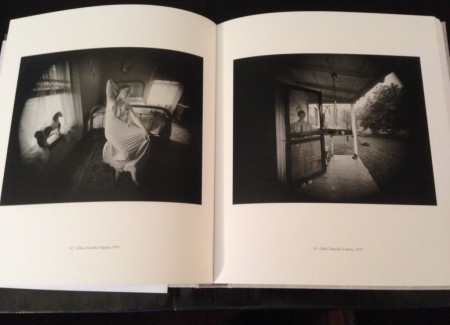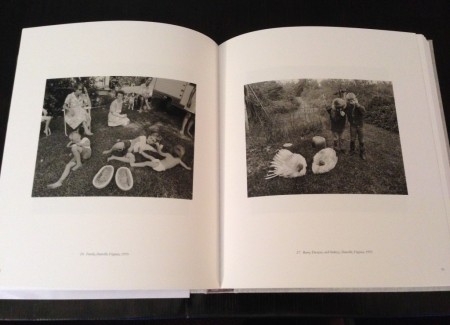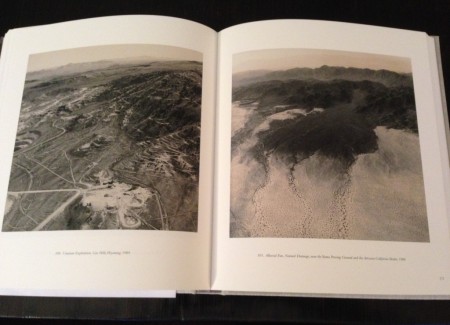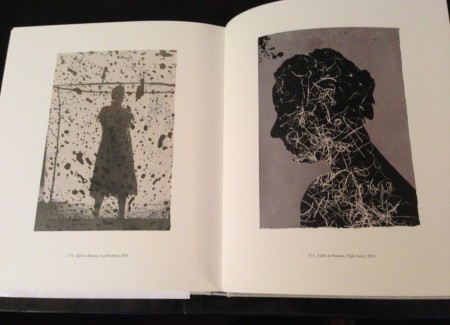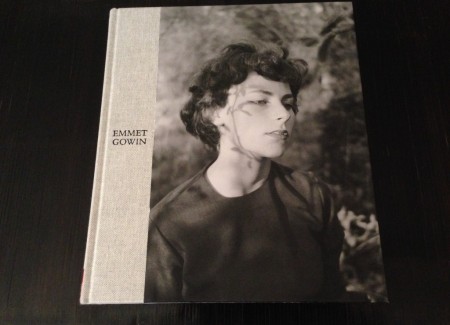JTF (just the facts): Published in 2013 by TF Editores/Fundación MAPFRE (here) and Aperture (here). Hardcover (roughly 10×12 inches), 240 pages, with 181 black and white and color photographs. Includes essays by Emmet Gowin, Carlos Gollonet, and Keith F. Davis and a chronology by Carlos Martin Garcia. (Spread shots below.)
Comments/Context: “From the beginning I wanted to make pictures so potent that I would not need to say anything about them.” So wrote 25 year-old Emmet Gowin in 1967. That a then-MFA candidate at RISD would go on during the next 45 years to fulfill his early desire can be seen on every page of this thick, nourishing catalog. Most of the images here, reproduced with the richness one takes for granted in a Gowin-supervised book, need no explication. Indeed, they resist it.
A dozen or so photographs of his wife, Edith, and their children from the late 1960s-early 1970s, have become icons of the period, dreamy visions of what music anthologist Harry Smith called “the old, weird America.” In both subject and style, Gowin’s pictures of rural life in Danville, Virginia express a belief in Jeffersonian America: the strength of extended family rooted in the economy of small farms. The smooth, bitter-sweet chocolate tones of his black- and-white prints, with their medium-format dimensions, are equally old-timey, a continuation of the fine-art values passed down from Stieglitz, Weston, Adams, to Gowin’s chief mentors, Harry Callahan and Frederick Sommer.
And yet photography in the art world since the days that Gowin wrote those 1967 words has not been hospitable to his peculiar brand of Southern romanticism. The warped space in his vignetted images from the 1970s seems to harken back before Modernism, to a time often clouded in nostalgia. Today’s curators and critics (and art students) prefer photographers to expose the ulterior motives behind their images. Gowin appears for the most part guileless.
His aerial views of American and European landscapes, whether taken in the 1980s and sepia-tinted, or done in 2012 in color, reveal the deficiencies in his approach. Stunning in their patterned beauty though these prints are (some of them among the loveliest he has made), they are easy to make because any view of the ground from the sky is arresting. What he wants us to think – emotionally and politically – about nuclear bomb tests or mining in the deserts of the Southwest isn’t at all clear either.
It is in his portraits of his wife, Edith, connected by blood to most everyone else here, that remain the center of his life and work. A 1963 portrait of her, seemingly unguarded, her pale skin shadowed in branches, graces the cover and should stop Barnes & Noble browsers in their tracks. The book ends with 22 images of her from the 1980s and ‘90s, tightly-cropped portraits as well as the 2003 series “Mariposas Nocturnas,” in which he uses various techniques—collage, long exposures, back-lighting, silhouetting—to surround her with images from nature: leaves, fluttery insects, bird’s nests, and moths. It is a triumph.
Like his older contemporary Robert Adams, along with younger admirers such as Judith Joy Ross, Sally Mann, and Mark Steinmetz, Gowin seems willing to risk being dismissed by ironists and deconstructors. He would prefer to be seen as too earnest (and perhaps sentimental) rather than sacrifice the belief of his artistic forebears that almost anything clearly described on a sheet of photographic can be ineffably beautiful. “Kisses are among the vehicles I would use if I were not able to make pictures,” he has said. I believe him but I’m glad he has chosen to keep taking photographs.
Collector’s POV: Emmet Gowin is represented in New York by Pace/MacGill Gallery (here). Gowin’s work is intermittently available in the secondary markets, with a handful of prints coming up for sale in any given year. Recent prices for single images have ranged from roughly $1000 to $10000, with portfolios and multi-print sets reaching $40000.
